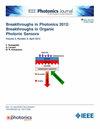模拟氮化铝基紫外发光二极管中的载流子注入效率
IF 2.1
4区 工程技术
Q3 ENGINEERING, ELECTRICAL & ELECTRONIC
引用次数: 0
摘要
为了了解深紫外光源的注入效率,我们对基于氮化铝镓的紫外发光二极管(UV-LED)中的载流子传输进行了数值模拟。我们的模拟器根据 265 纳米紫外发光二极管的实验数据进行了校准,分析了量子效率。最大内部量子效率(IQE)为 30%,包括辐射重组效率(RRE)60% 和载流子注入效率(CIE)50% 的乘积。研究发现,有源区空穴注入不足和电子过剩限制了这两种效率,并导致大量电子泄漏到 p 面。这种泄漏与偏压有关,并在最大 IQE 时达到最小值。进一步的模拟显示,分布式极化掺杂(DPD)可以提高载流子注入效率。本文章由计算机程序翻译,如有差异,请以英文原文为准。
Simulation of Carrier Injection Efficiency in AlGaN-Based UV-Light-Emitting Diodes
Numerical simulations of carrier transport in aluminium gallium nitride based ultraviolet light emitting diodes (UV-LED) are performed in order to understand injection efficiency for light sources in the deep ultraviolet. With our simulator, calibrated with experimental data from a 265 nm UV-LED, quantum efficiencies have been analyzed. The maximum internal quantum efficiency (IQE) of 30% consists of the product from radiative recombination efficiency (RRE) of 60% and carrier injection efficiency (CIE) of 50%. It is found that poor hole injection into the active region and a surplus of electrons limit both efficiencies, and leads to significant electron leakage into the p-side. This leakage is bias dependent, and has a minimum at maximum IQE. Further simulations show that distributed polarization doping (DPD) could improve carrier injection efficiency.
求助全文
通过发布文献求助,成功后即可免费获取论文全文。
去求助
来源期刊

IEEE Photonics Journal
ENGINEERING, ELECTRICAL & ELECTRONIC-OPTICS
CiteScore
4.50
自引率
8.30%
发文量
489
审稿时长
1.4 months
期刊介绍:
Breakthroughs in the generation of light and in its control and utilization have given rise to the field of Photonics, a rapidly expanding area of science and technology with major technological and economic impact. Photonics integrates quantum electronics and optics to accelerate progress in the generation of novel photon sources and in their utilization in emerging applications at the micro and nano scales spanning from the far-infrared/THz to the x-ray region of the electromagnetic spectrum. IEEE Photonics Journal is an online-only journal dedicated to the rapid disclosure of top-quality peer-reviewed research at the forefront of all areas of photonics. Contributions addressing issues ranging from fundamental understanding to emerging technologies and applications are within the scope of the Journal. The Journal includes topics in: Photon sources from far infrared to X-rays, Photonics materials and engineered photonic structures, Integrated optics and optoelectronic, Ultrafast, attosecond, high field and short wavelength photonics, Biophotonics, including DNA photonics, Nanophotonics, Magnetophotonics, Fundamentals of light propagation and interaction; nonlinear effects, Optical data storage, Fiber optics and optical communications devices, systems, and technologies, Micro Opto Electro Mechanical Systems (MOEMS), Microwave photonics, Optical Sensors.
 求助内容:
求助内容: 应助结果提醒方式:
应助结果提醒方式:


